Frances Paola Garnica Quiñones
El Colegio de San Luis, San Luis Potosí, Mexico.
is a Conacyt postdoctoral fellow at El Colegio de San Luis. She holds a master's degree and PhD in Social Anthropology with Visual Media from the University of Manchester, UK. Her research topics include the perception and imaginary of spaces, Chinese migration in San Luis Potosi and ritual and therapeutic uses of peyote from a biocultural territory defense approach. She is co-director of the documentary ...And I'm not leaving the neighborhood! (2019).
Orcid: https://orcid.org/0000-0001-6957-1299
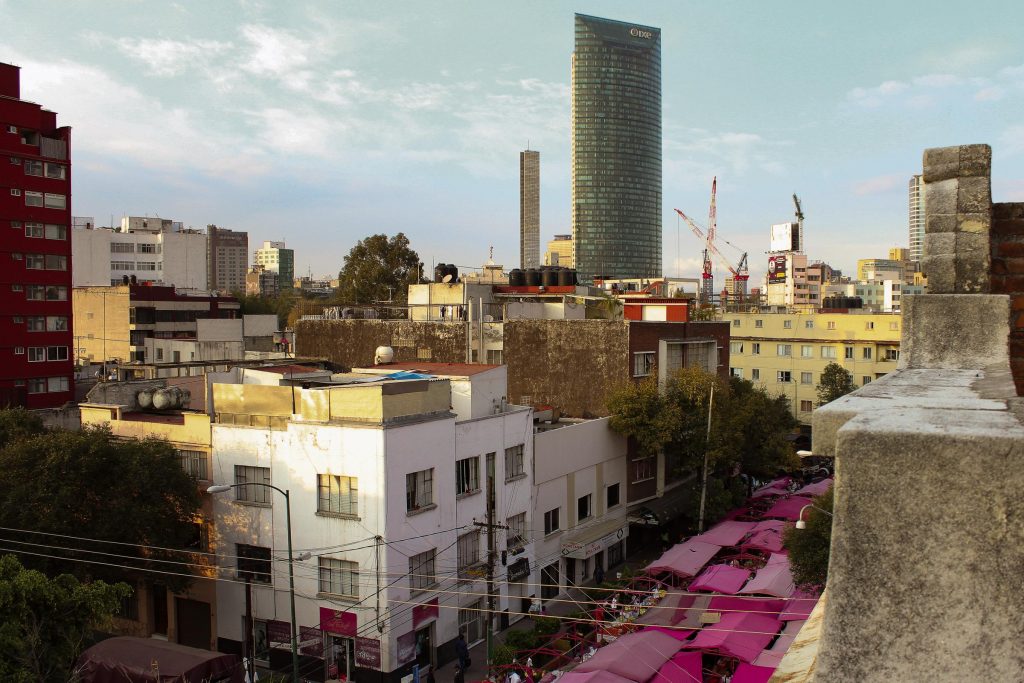
Image 1
Tianguis: a place to watch
CDMX, 2012.
Once a week the Ruta 8 de Mercados sobre Ruedas is installed in eight different neighborhoods of the CDMX. People visit with certain expectations of the place:
The tianguis is a light bulb on, a journey, a back and forth, going in search of something with the desire to get something, open space, without walls, without walls. There is room for everyone; it is a tradition, an adventure, a means of sustenance, a job and a chinga. - Rodrigo, dealer.
Picture 2
"The tianguis can be seen, smelled and touched" (Jorge, art dealer).
CDMX, 2013.
The atmosphere of a tianguis is generated in large part thanks to the work that tianguistas put into the presentation of their stalls.
The main expectations of a tianguis from the perspective of the marchantes are that, 1) its installation is on the public street, 2) there is an atmosphere of exploration, sociability and personalized attention, 3) there are products that are not found in other establishments and at low cost, 4) the visit is recreational and enjoyable, 5) there is room for maneuver in the commercial exchange, such as bargaining and bargaining.
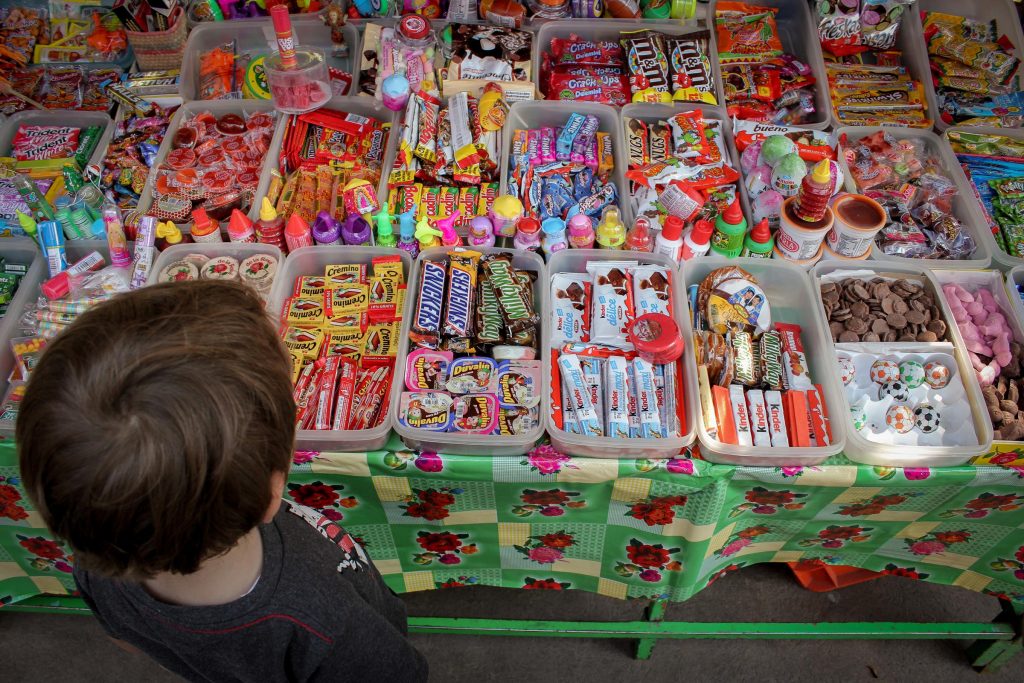

Picture 3
"Why do I always get hungry at the tianguis?" (Carlos, dealer)
CDMX, 2013.
These expectations are not the result of a marketing study where the preferences of the potential clientele were calculated and then the tianguistas created and executed an action plan accordingly. They are the result of the observations and adaptations made by the tianguistas in order to set up a street sale. They bring together a series of knowledge about the use of space, hygiene, product presentation, interaction with vendors and internal social organization. Since stalls are usually passed down from father to son or daughter, this knowledge is acquired and inherited over decades of coexistence with vendors.
Picture 4
Assemble the stand
CDMX, 2013.
At eight o'clock in the morning, the constant whistle of the devils or chargers alerts pedestrians walking in the middle of the traffic of devils (wheelbarrows). Heavy wooden boards on the floor mark the place of each stall. Half-assembled stalls, like skeletons, wait to be dressed. But the tianguistas must take into account the rules imposed by the association itself, the government and the neighbors of each neighborhood: install the awning of the indicated color, have the stall tubes painted in the same color, do not exceed the allotted meters, do not ruin flower boxes or fences of the neighborhood, keep the boxes and other materials tidy in the back of the stall and avoid cables, ropes and obstacles in the aisles, among others.

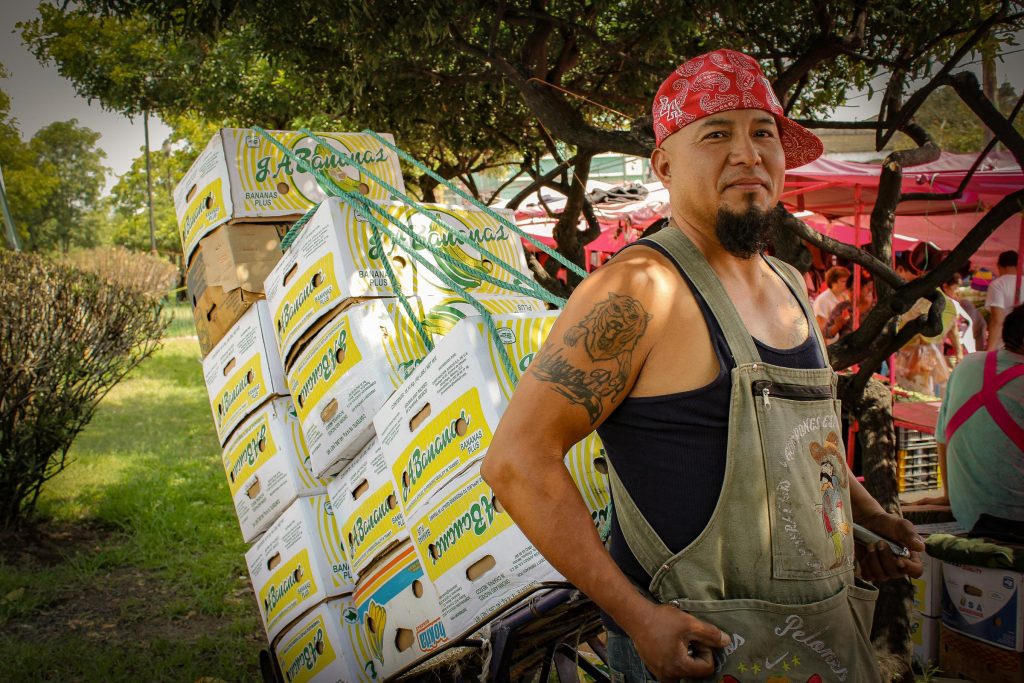
Picture 5
Diablero
CDMX, 2013.
The diableros perform work that requires great physical effort. A diablero can carry up to 100 kilos. They load, unload, assemble and disassemble the tubes of the stand. They can also act as assistants, serving customers and giving "testers" to the vendors. For many migrants, this job is their first entry into the world of work in the CDMX, as the requirements are minimal.
Picture 6
Assistant
CDMX, 2013.
The stall owners usually hire employees to help them unload the merchandise and set up every day. The tianguistas who do not have their own cargo truck hire freight drivers who store the merchandise in their truck overnight and deliver it early in the morning to the neighborhood where the tianguis is to be set up.
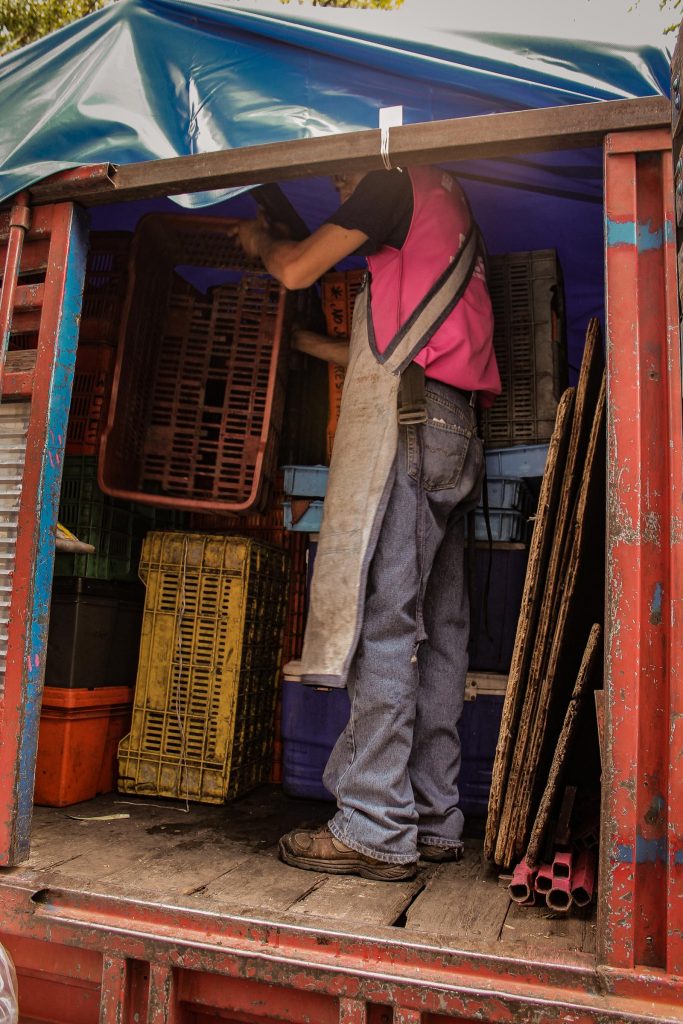

Picture 7
The tailor of the post
CDMX, 2012.
Abel, an assistant at the banana stand, resembles a tailor who puts the finishing touches on the stand. A native of Veracruz, he considers his trade to be that of a farmer, but he has developed diverse skills over ten years of handling the stall's structural materials. Abel prepares and adapts the stall for possible weather conditions: clear, rainy or windy. He uses coins that he wraps and ties around the corners of the stall's canopy to get a better grip. He says he likes this work because it awakens his creativity.
Picture 8
The art of banana placement
CDMX, 2012.
Abel takes the bunches of bananas from the rows he already formed and, with a curved knife, skillfully cuts the top of the stem without splitting the bananas, making the joint look flatter:
I'm giving them a view. It's more attractive; the bananas look fresher and more appetizing..
Giving a view consists of working on the aesthetic and spatial presentation of the stand and the products that compose it.
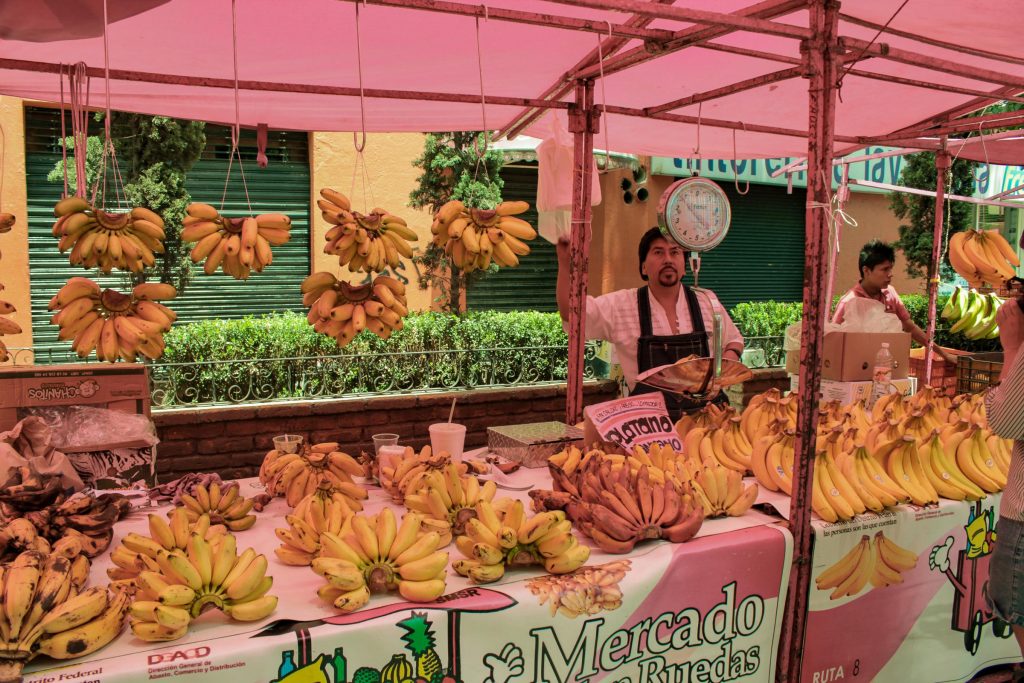
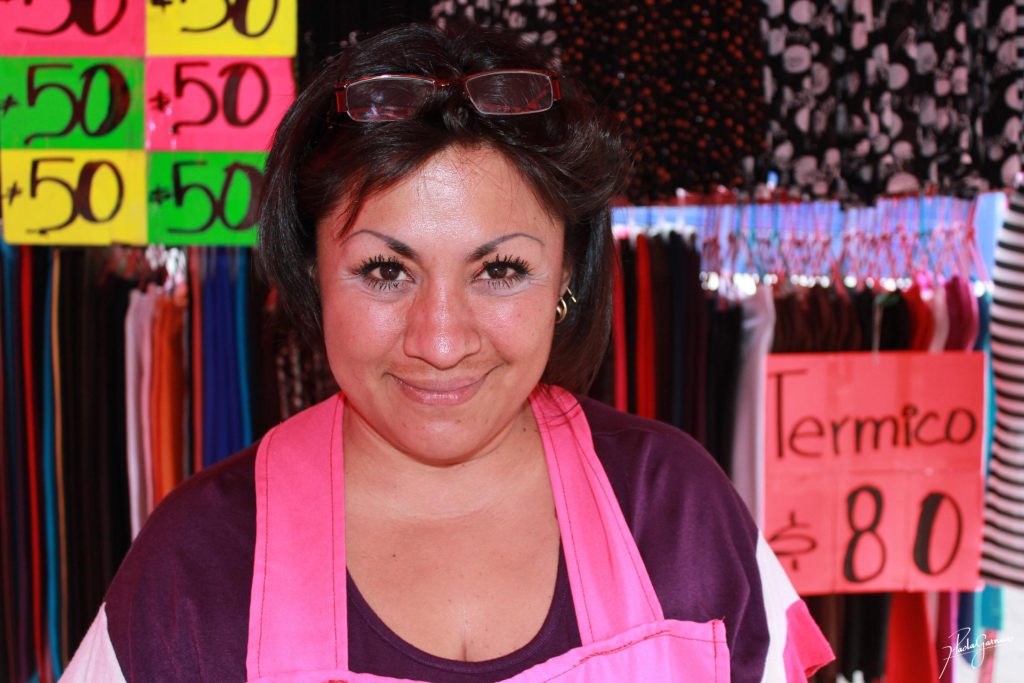
Picture 9
The stocking stall
CDMX, 2012.
A few meters from the banana stand, Olimpia is unpacking the merchandise from her hosiery stand. Her mother inherited it from her. After a hired loader assembles her two-meter stand and places large drums full of clothes, Olimpia arranges the merchandise. As part of give view to her stall, she also often dresses her merchandise, a strategy that has helped her sell.
Picture 10
Giving sight is inherited
CDMX, 2012.
On the front counter, Olimpia places colorful socks that she has had dyed, because it's cheaper. She stretches them along the corner of the stall, creating a rainbow of nylon. Light filters through the transparent material, highlighting the delicate patterns of the stockings, which are hung like invisible legs. Bundles of stockings portraying several white-skinned blonde women hang at the front of the stall, swaying delicately in the morning breeze.
From my mother I learned to show my stockings like this. She always told me to hang up my stockings just like this. They look great, don't they? Don't they? Look at them. - Olimpia, tianguista.
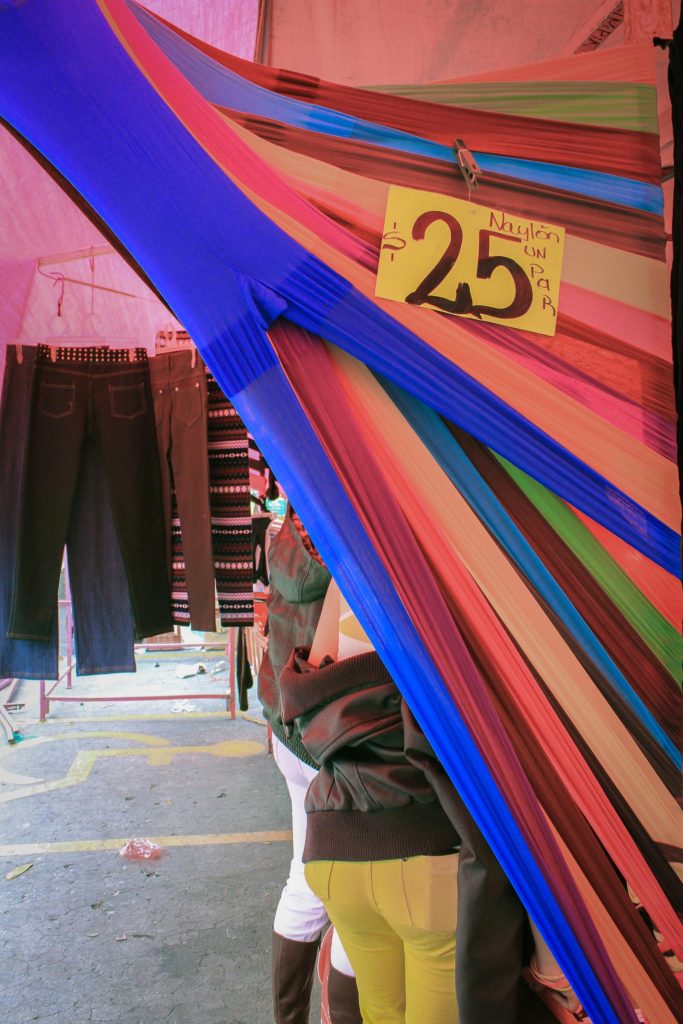

Picture 11
Variety in 2 meters
CDMX, 2012.
The extensive variety of merchandise that Olimpia handles includes more than a hundred different products. After three hours of arranging socks, tights, leggings, tights, stockings, lycra skirts and so on, Olimpia arranges her seat, which consists of a stack of box tops on a storage box, and checks on Galleta, her little French Poodle who is napping very comfortably on a cushion.
Picture 12
Giving a view is innovation
CDMX, 2013.
During the 1980s, before the Free Trade Agreement, the tianguis were the place where innovations were found. Things that were not allowed to be sold were sold freely in the tianguis. It was a place of novelties. People liked to find something new, even if it was the same thing, but in a different form, for example, curiosities, like jicama. Instead of selling it in a jar, you put a stick to the slice of jicama and it becomes a special popsicle called "jicaleta". That's something innovative and it was sold at the tianguis. Fruit covered with chocolate, things like that. The idea was to look for something attractive, something curious. It was more than just satisfying a desire to consume. - Roberto, tianguista.
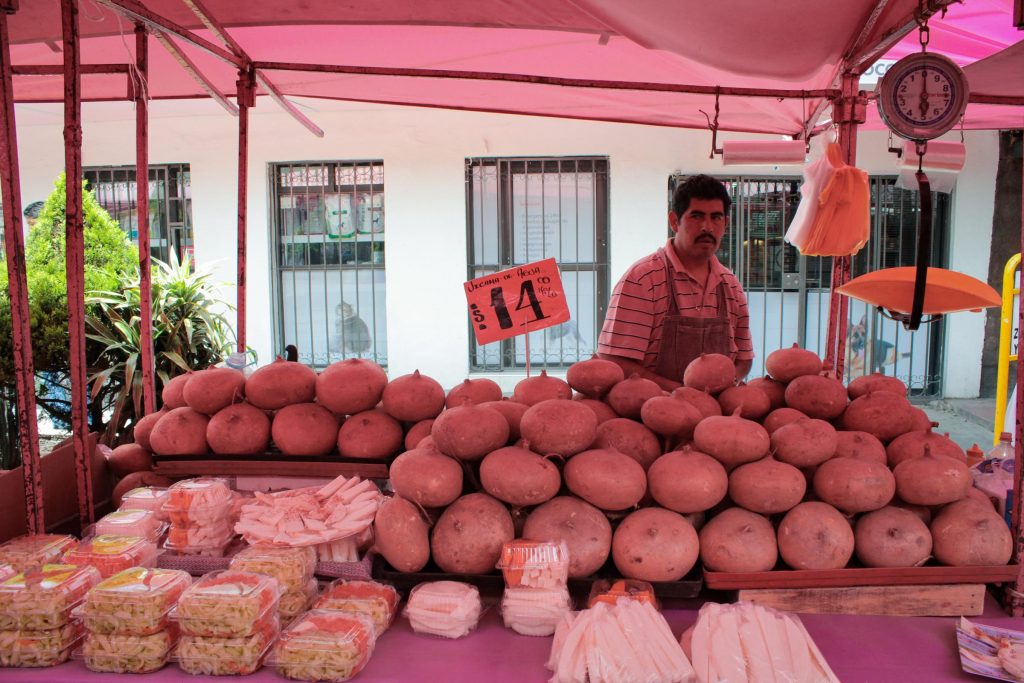
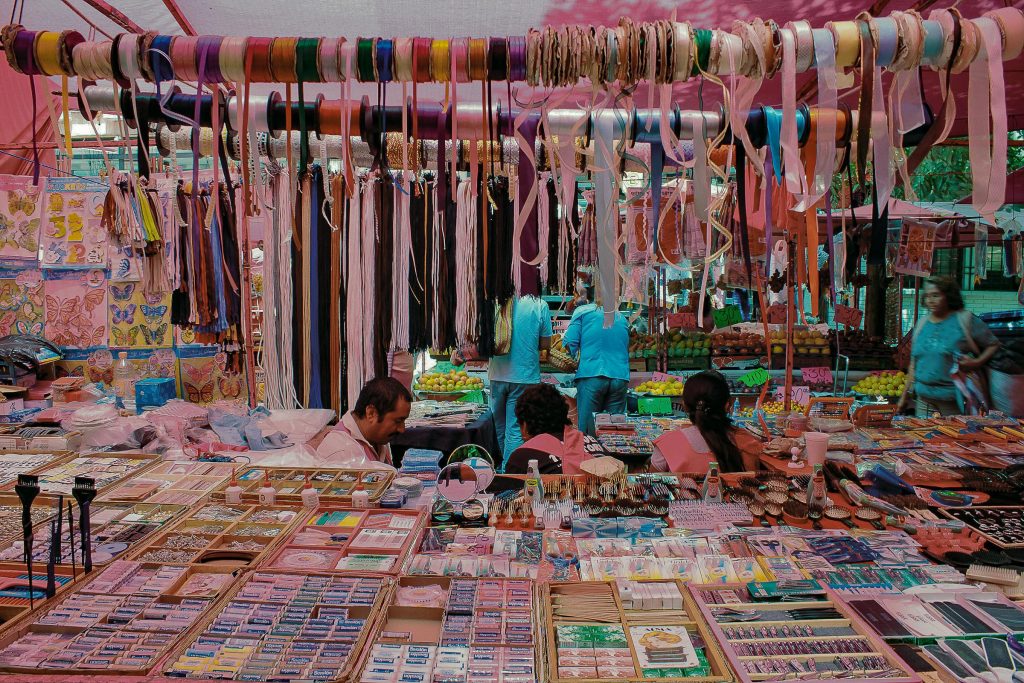
Picture 13
Recognition comes through the eyes
CDMX, 2012.
On Sunday more foreigners arrive and I would imagine that in their countries there are not as many things as here. It is a marvel for them to see our work, because it is not easy to arrive and find everything already shaped, washed, cut, sliced; it is a great task that we do from very early in the morning and they are amazed. And they see it as a treasure that we have. I don't know, maybe, if we had it every day, it became more habitual and maybe you don't value it so much. You see the enthusiasm, the expression on their faces, how they stand with their cameras, film and ask for permission. Many are more observant. They try to see the structures we have to work with, because it is not easy, and they are even more amazed when they go the next day and there is nothing of what they saw the day before.. - Abel, tianguista.
Picture 14
The good trader
CDMX, 2012.
The tianguis reminds you not to assume that there are no faces on the fruit. Here at the tianguis, you can see that the vendors work for the goods. They share their knowledge about the produce, how it can be eaten. It's a more direct approach, not like in the storefronts. - Octavio, art dealer.
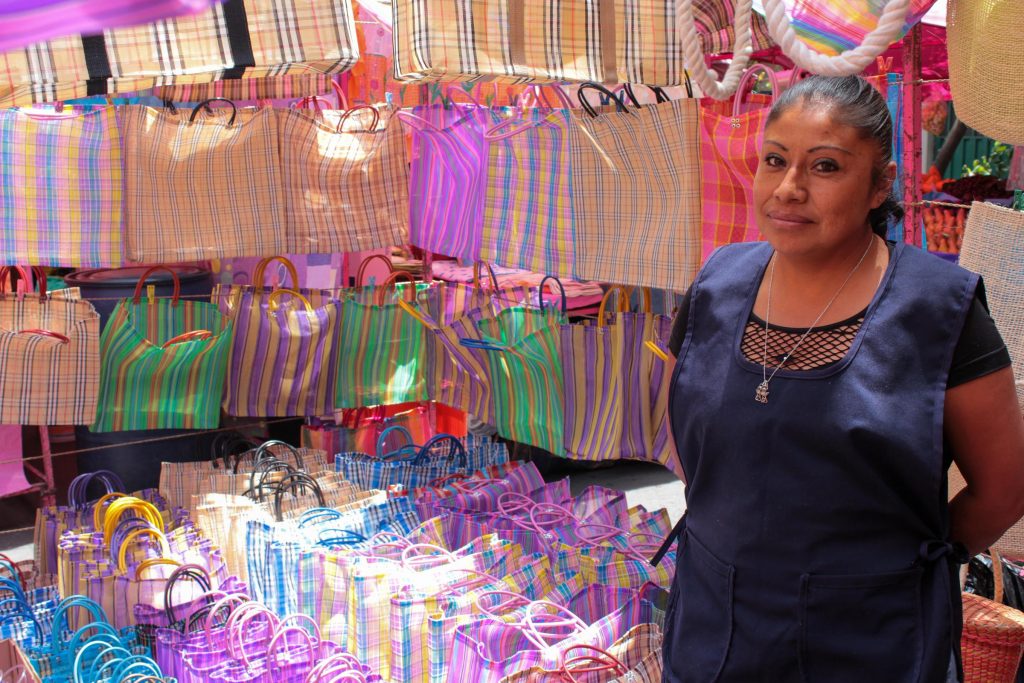
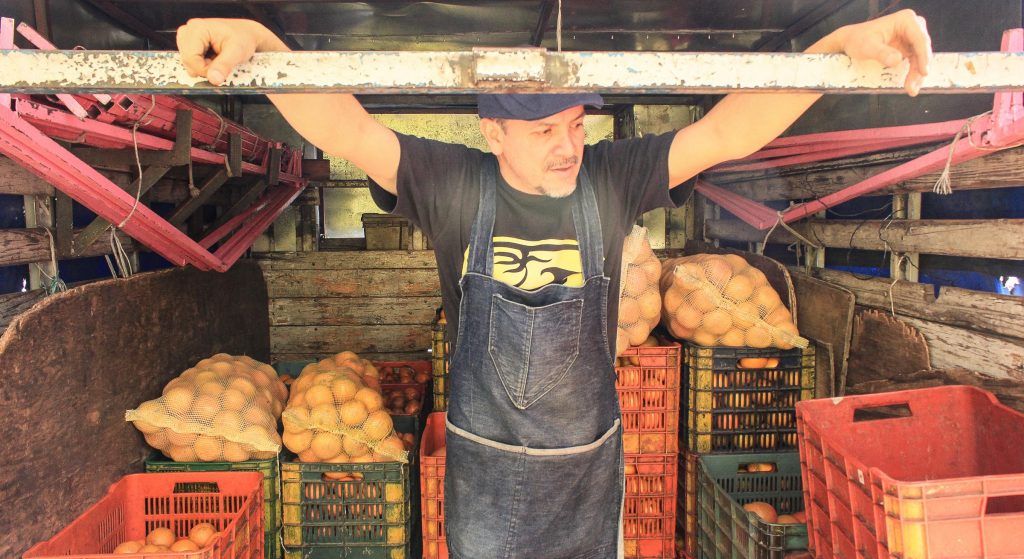
Picture 15
Oranges with a view
CDMX, 2013.
Twice a week Roberto, tianguista and representative of Route 8, buys 90 kgs. of oranges in arpilla, as many kilos of Valencia oranges, grapefruit and pineapples.
In Abastos, a higher monetary value is given to oranges that "have eyesight", that is, those that are large in size -and therefore heavier-, uniform in color and without blemishes.
Picture 16
Automatic and manual aesthetic selection
CDMX, 2013.
At the Central de Abastos, a machine sorts the oranges by size and, via a conveyor belt, sorts them into compartments. Once the oranges have fallen into these compartments, two fruit sorters pick them up and manually select the oranges that have spots or dents.
Some fruits get leaves stuck to them when they are growing and get stained. We take care of this. We select the best ones, and the ugly ones we remove so that the fruit has a better presentation. This is what helps people consume more.- Ángel, worker at the Central de Abastos.
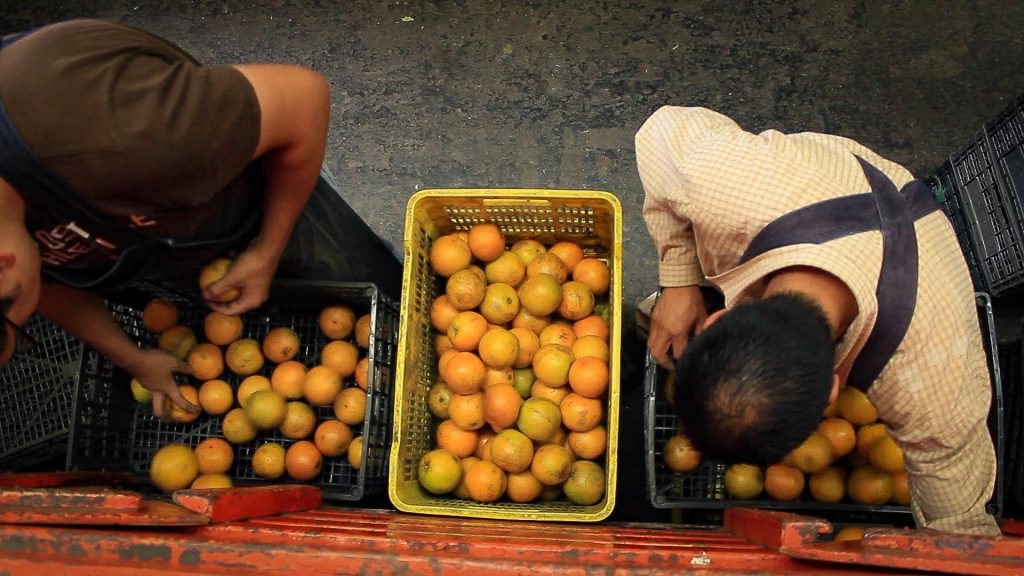

Picture 17
Back at the post
CDMX, 2013.
Roberto finally arranges the oranges in his stand. These oranges have gone through a selection process that is part of a chain involving the aesthetics of the product. The oranges with the "best look" are given at a more expensive price to the dealer. Roberto also sources oranges for juice, pineapples and grapefruit.
Picture 18
Map of a tianguis stand set up in the vicinity of the Velódromo sports center.
CDMX, 2013.
These are the basic elements that make up the assembly and presentation of a Ruta 8 citrus stand. Variations tend to occur with respect to the type of products being sold, the neighborhood where the stand is set up, where space may be larger on some streets than on others, and the needs of the vendors. Annexes are more tolerated in Velódromo, where there is much more space than, for example, in La Condesa.
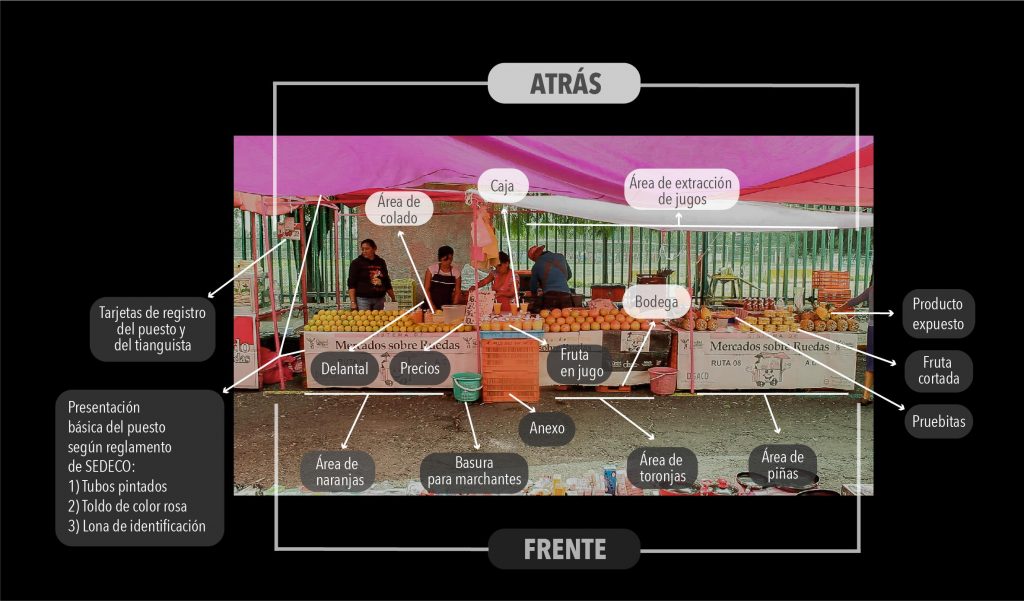
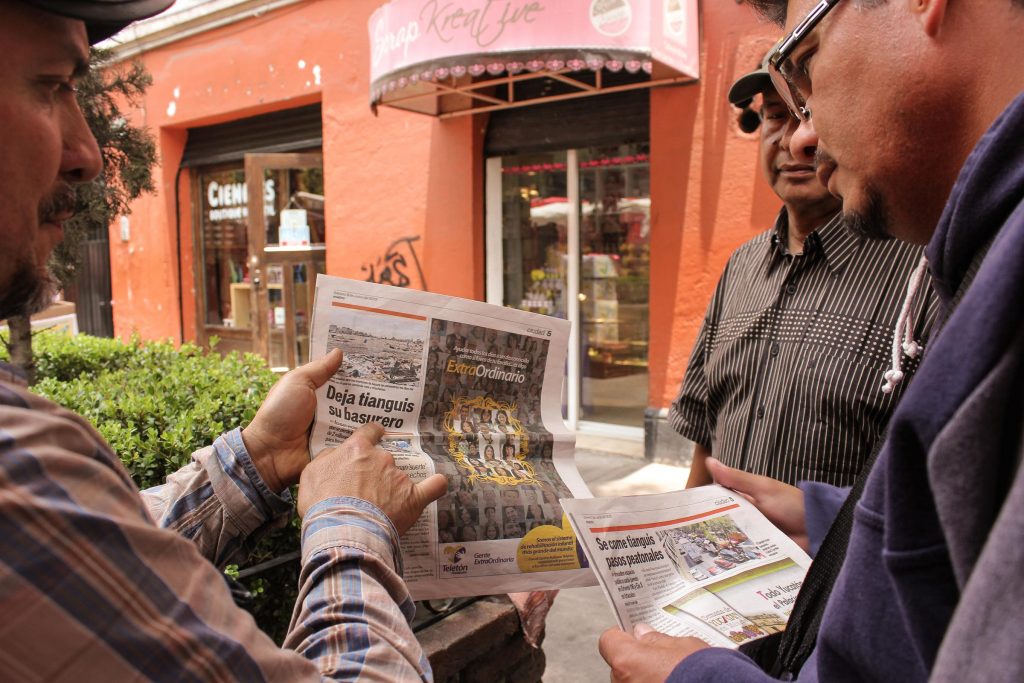
Picture 19
Social control and view
CDMX, 2013.
Roberto, as a representative of Ruta 8, along with the coordinator of the Markets on Wheels Program and a representative of a neighborhood committee, review the news to measure risks, threats and points for improvement. They set out to carry out the monthly supervision of Ruta 8's facilities in the Condesa neighborhood. The criteria for this supervision focus on the presentation of the stall and the use of the space.
Picture 20
Aisle width
CDMX, 2013.
Roberto measures the aisle space together with the coordinator. Maintaining an adequate width is important to maintain a comfortable and safe circulation of people. We also check that there are no annexes or extensions of stalls beyond the permitted measurements, to avoid unfair competition among vendors.
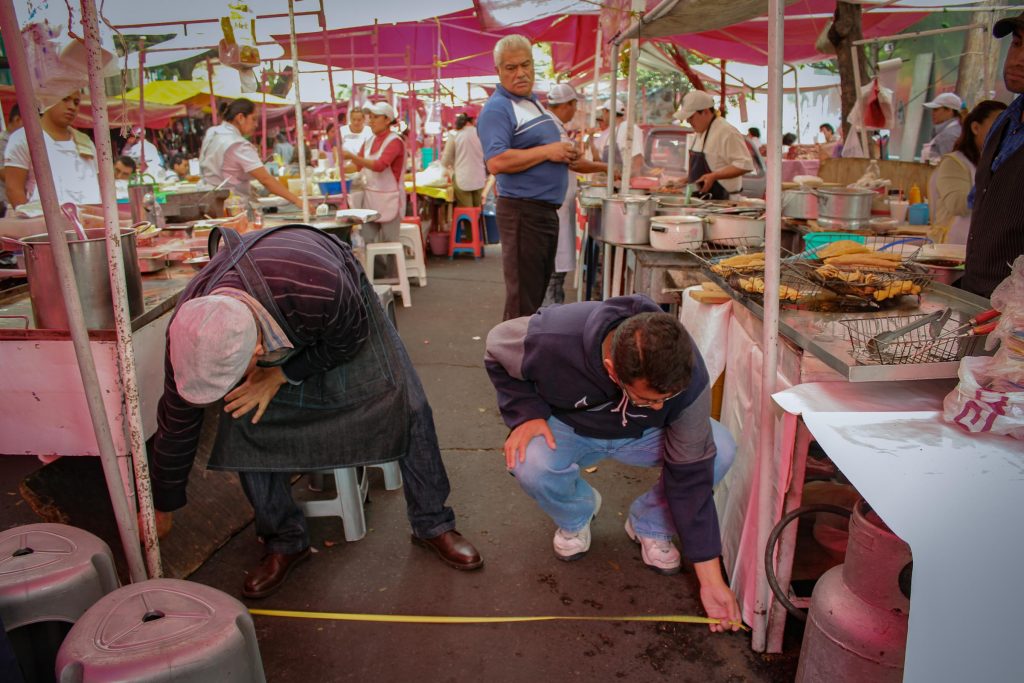
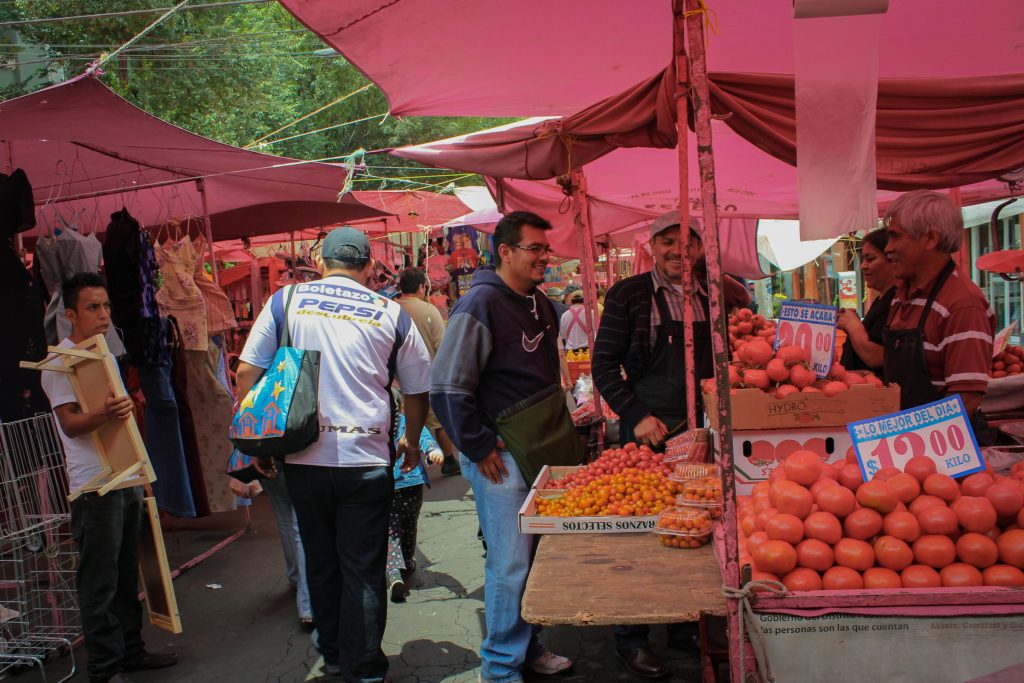
Picture 21
Annexes
CDMX, 2013.
An annex is any extension of a tianguis stall. Annexes can obstruct the circulation space of the aisle and also invade the space of another trader's stall. Some tianguistas also denounce the invasion of their stalls with annexes of others:
If I don't complain, I get more space tomorrow.. - Tianguista of Route 8.
Picture 22
Inches away from unfair competition
CDMX, 2012.
Exceeding the spatial limitations of a stall can translate into a problem for tianguistas. The consequences of annexes are often complaints by customers and neighbors to the local government or the media, which contributes to a damaging public image of the tianguis and the suspension of working days for traders by the authorities.
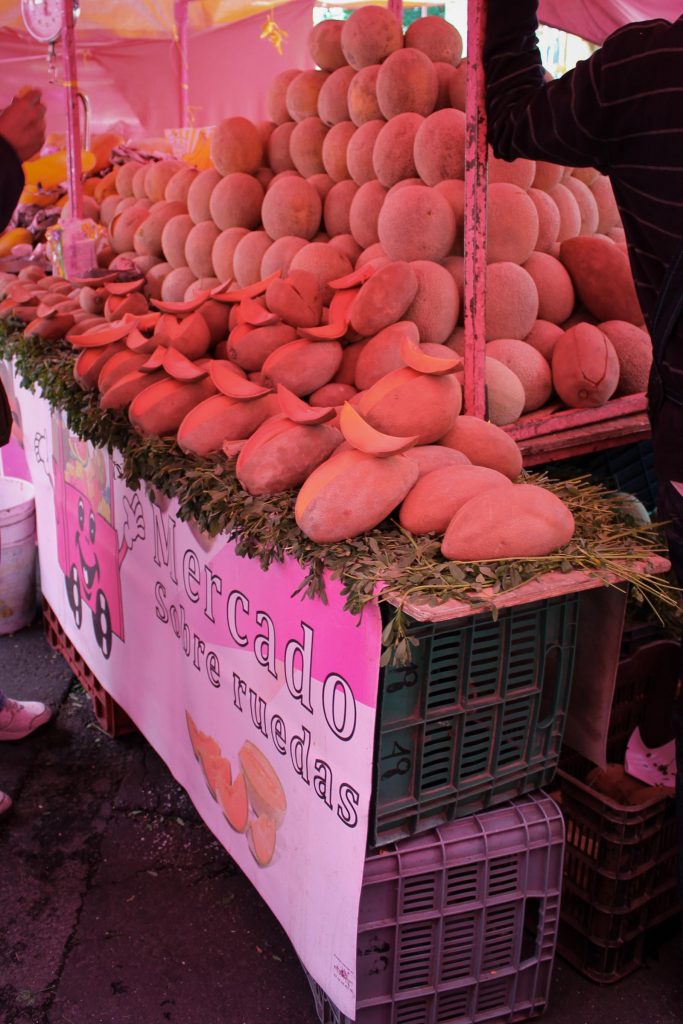

Picture 23
Walking without burning
CDMX, 2013.
It is also checked that there are no hot stoves, boxes, electric cables or other objects that could compromise the safety of the marchers. In the image, these indications are directed to merchants of stalls that do not necessarily belong to the Ruta 8 association but that are installed in some neighborhoods together with them. These stalls may be independent or belong to other tianguista associations. However, for Roberto it is important that these stalls abide by the rules, because otherwise "we can all be lumped together".
Picture 24
Circulators
CDMX, 2013.
The criteria that are reviewed during an aisle supervision are based on the people who walk the tianguis, especially those with limitations, such as the elderly, children in strollers and people with disabilities.
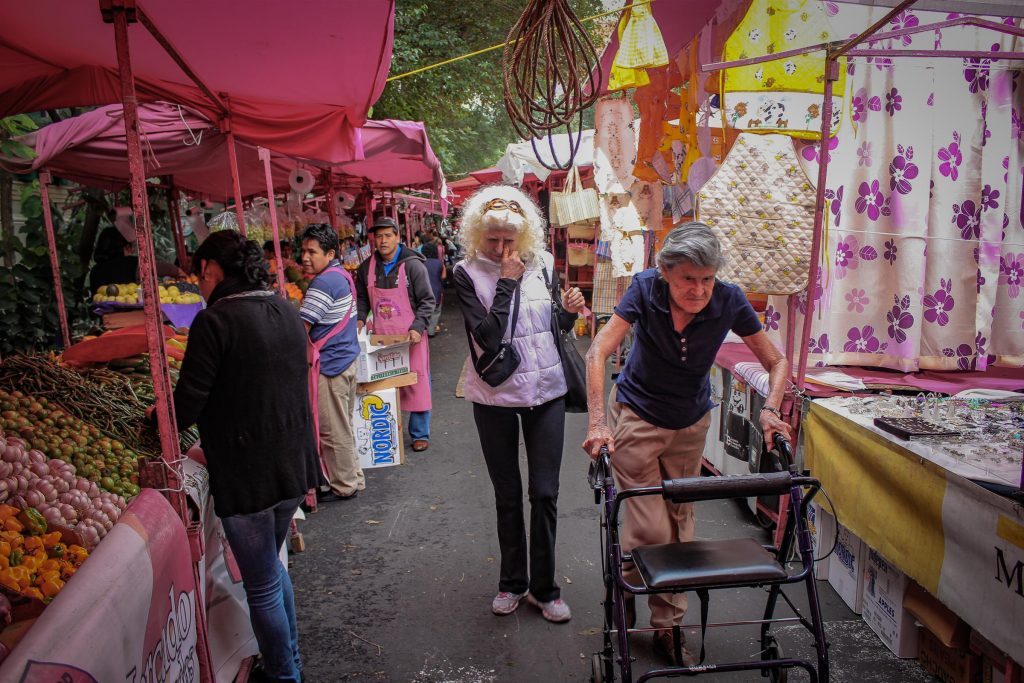
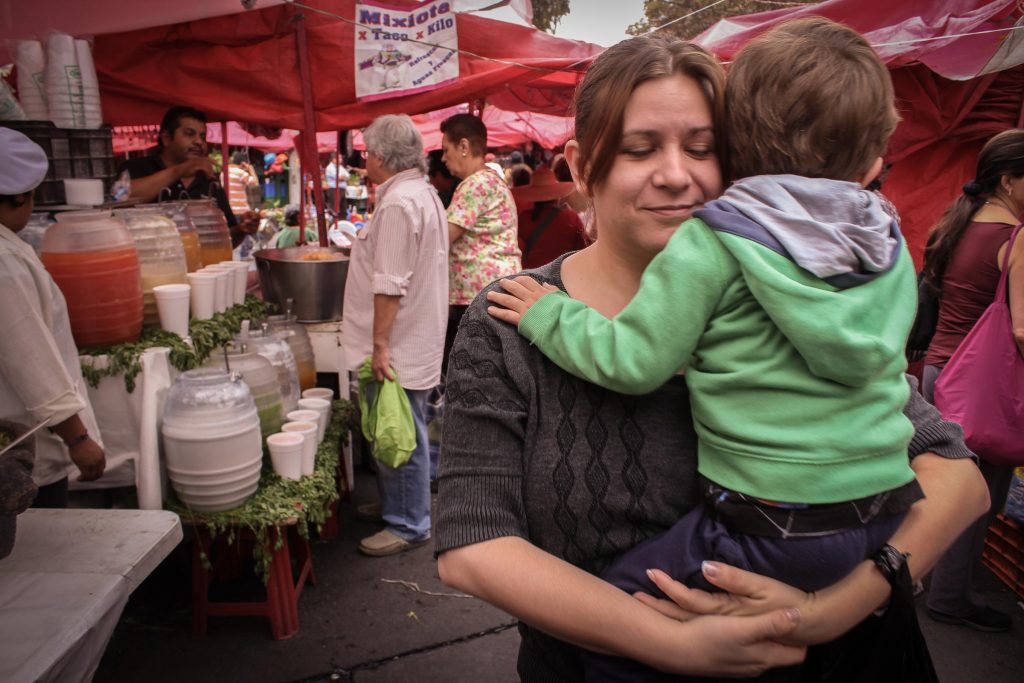
Picture 25
Taking care of the dealer's space
CDMX, 2012.
The tianguis plays an important economic and social role in the leisure time of this marchanta and her son. The tianguis, in addition to saving her a long trip to a park or other recreational place, is inexpensive. CMDX residents grow with the tianguis, whether out of necessity or entertainment, and the tianguis grows along with them. Recurring clientele is a tianguista's main income. Therefore, taking care of the stalls and avoiding complaints from neighbors helps to maintain the tianguis economically and socially. But, beyond work, tianguistas have maintained relationships with up to four generations of marchantes, many are close and trusting, and there have even been several cases of marriages between tianguistas and marchantes.
Picture 26
The little test
CDMX, 2013.
The housewife is suspicious and the salesman redoubles his courtesies. - Carlos Monsiváis (2000, p. 223).
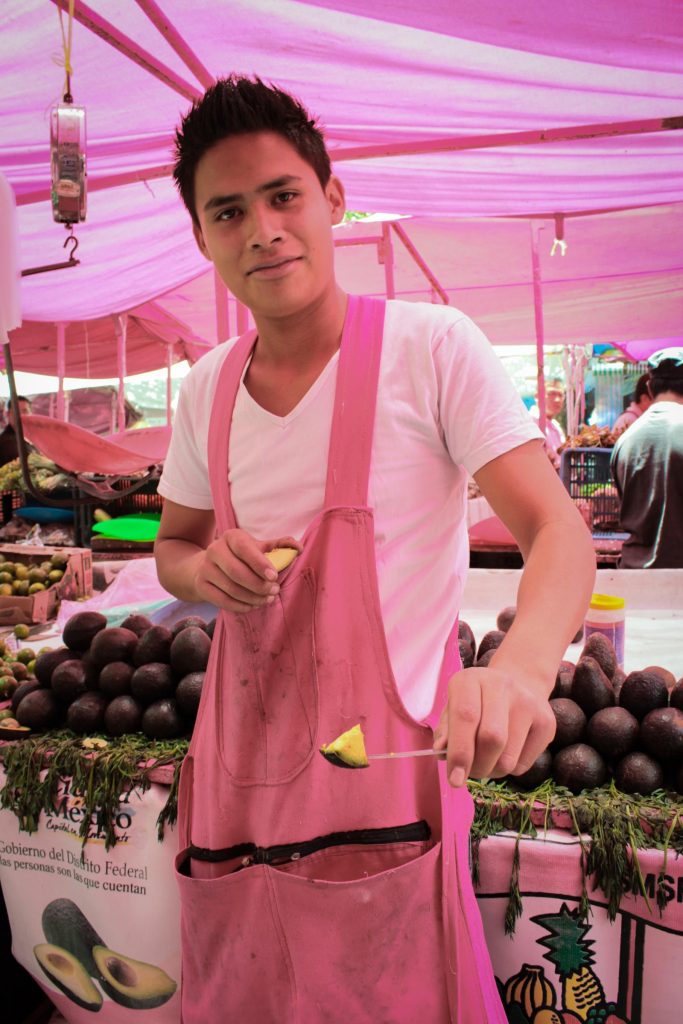
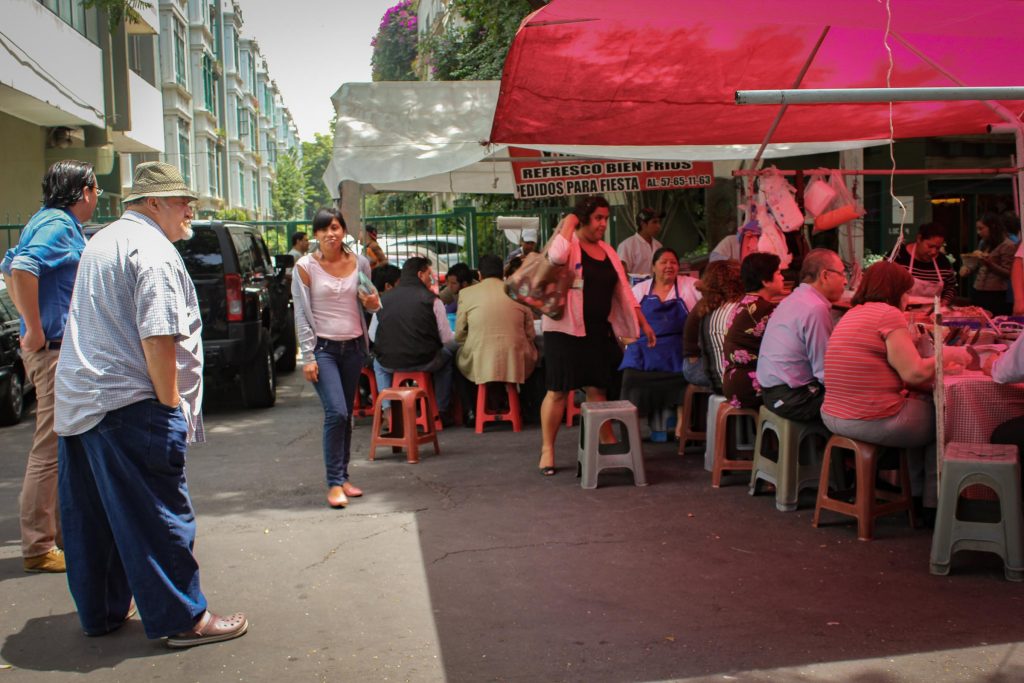
Picture 27
The neighbors
CDMX, 2013.
In neighborhoods such as La Condesa, the political participation of neighbors through neighborhood committees has forced tianguistas to pay special attention to the aesthetics of their stalls. Complaints in high-class neighborhoods reach the tianguis representative very quickly, and if they are not addressed, the neighborhood committees often take legal action. Roberto thinks that in these areas people get more involved because they have the time to do so, while complaints are infrequent in lower class areas because:
People are too busy working and don't have time to participate. - Roberto, tianguista.
Picture 28
Cars vs. stalls
CDMX, 2013.
"Oh no, why didn't you tell me, I didn't know today was tianguis day!" said a young woman to the security guard of the building she was exiting. Next to the young woman's trapped car, vendors who were supposed to be assembling their stall were standing on the pavement next to unpacked packages of the merchandise they were supposed to be selling. One of them commented to the others, "We're losing a good day's work."
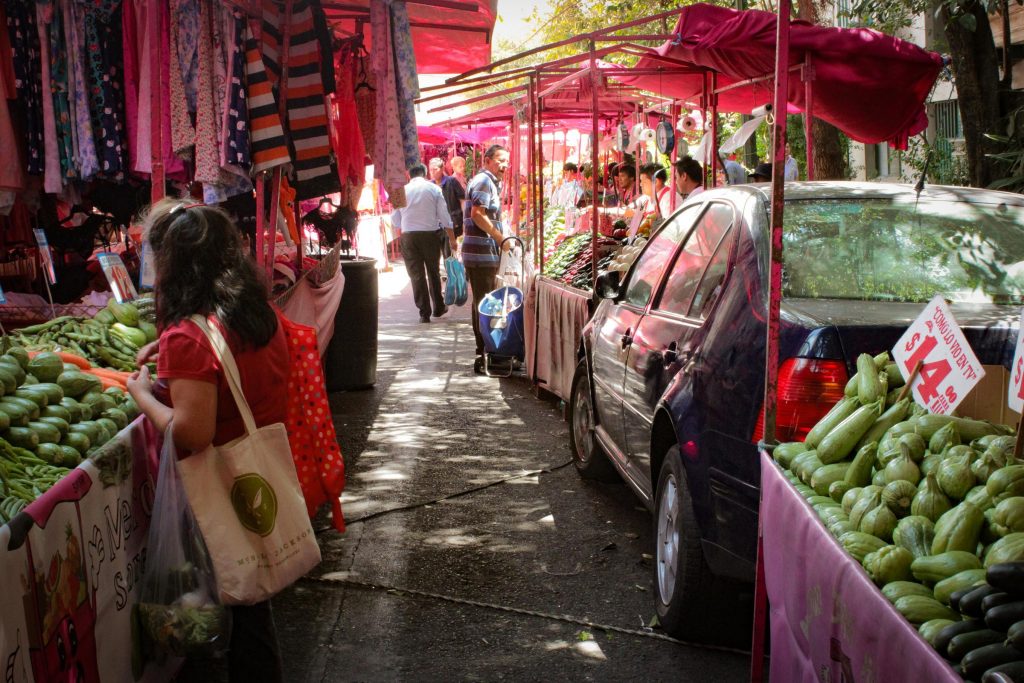
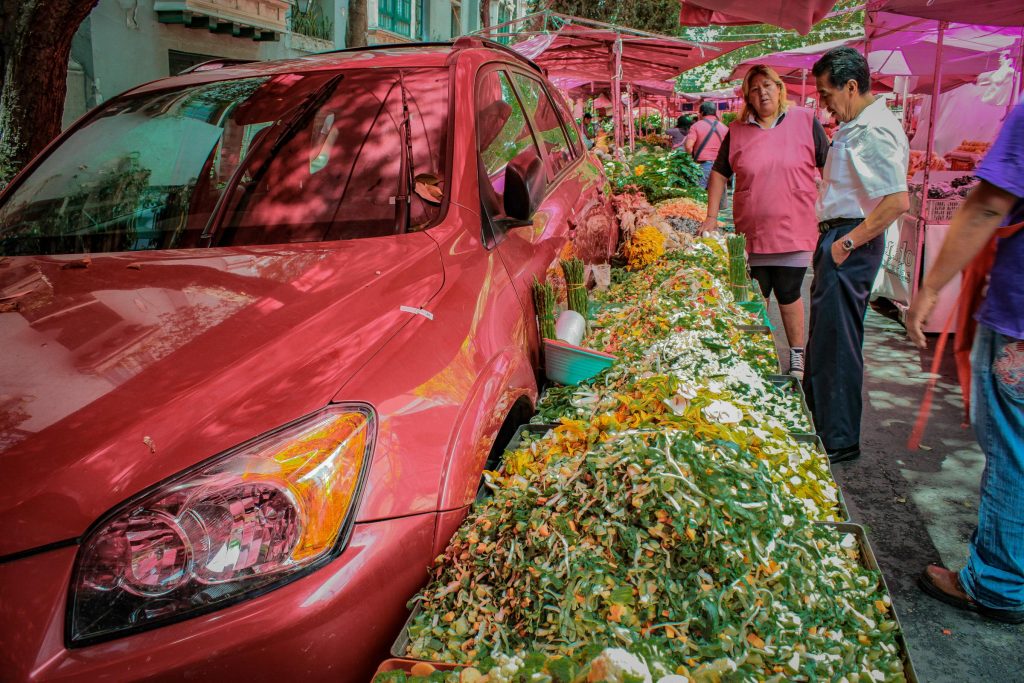
Image 29
Improvisation
CDMX, 2013.
The most flexible thing in the universe is space, there is always room for another person and another and another, and in the Metro, human density is not synonymous with the struggle for life, but rather, the opposite. Success is not about surviving, but about finding space in space. How can two objects not occupy the same place at the same time?
Carlos Monsiváis (2000, pp. 111-112).
Image 30
Residential rights or right to work?
CDMX, 2013.
The temporary solution is to install the post around the car. This type of situation causes tension and conflicts with neighbors and sparks discussion about who has more or less right to the street. The tianguistas prioritize the neighbors' right to the street in virtue of their right to work on the established day.
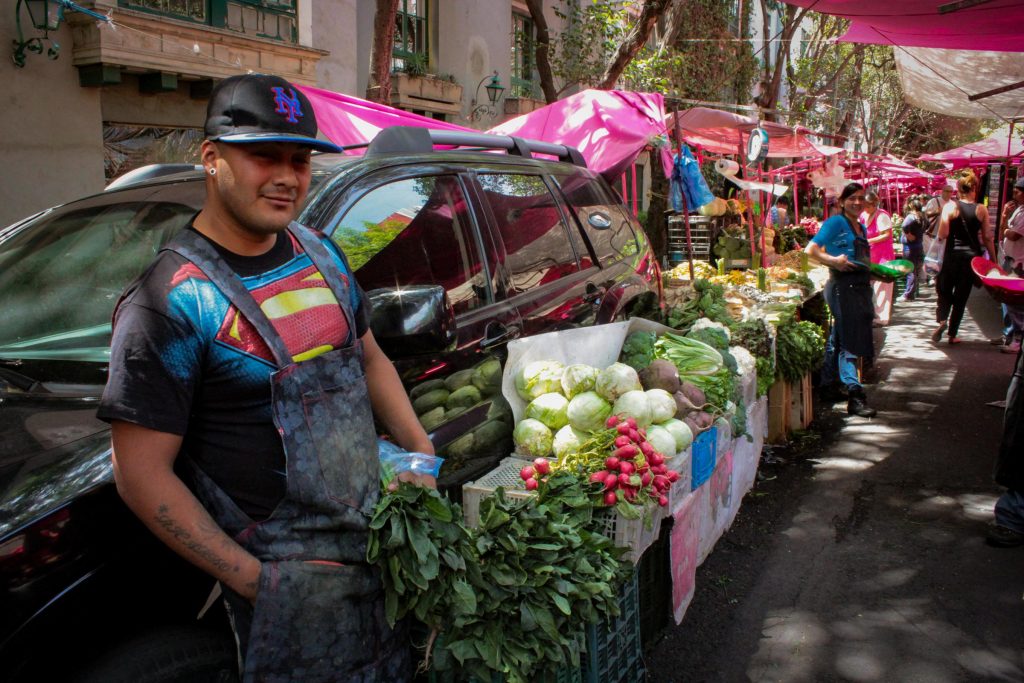
Image 31
The apron, pride at work
CDMX, 2013.
"You can catch me tired but never without the desire to sell," reads the apron of this helper. It is common to find these types of messages that reinforce the tianguistas' pride in their work.
Articles published in the media and in some government speeches, use words such as "combat" or "attack" together with the words "tianguis" or "informal commerce", "disorder", "garbage" and "dirt". Faced with such public opinions, Victor, tianguista leader, responds:
There are all kinds of people, those who like and those who do not like to go to the tianguis, but if they lack something, they go to the tianguis. Many people used to say: "filthy tianguistas", but it is a filth of work, it is a filth of effort, it is a filth of necessity, it is not a filth of laziness or of sitting down and getting dusty. It is something that, finally, must be respected because the work of a garbage collector is as worthy as that of a tianguista, as of an engineer.
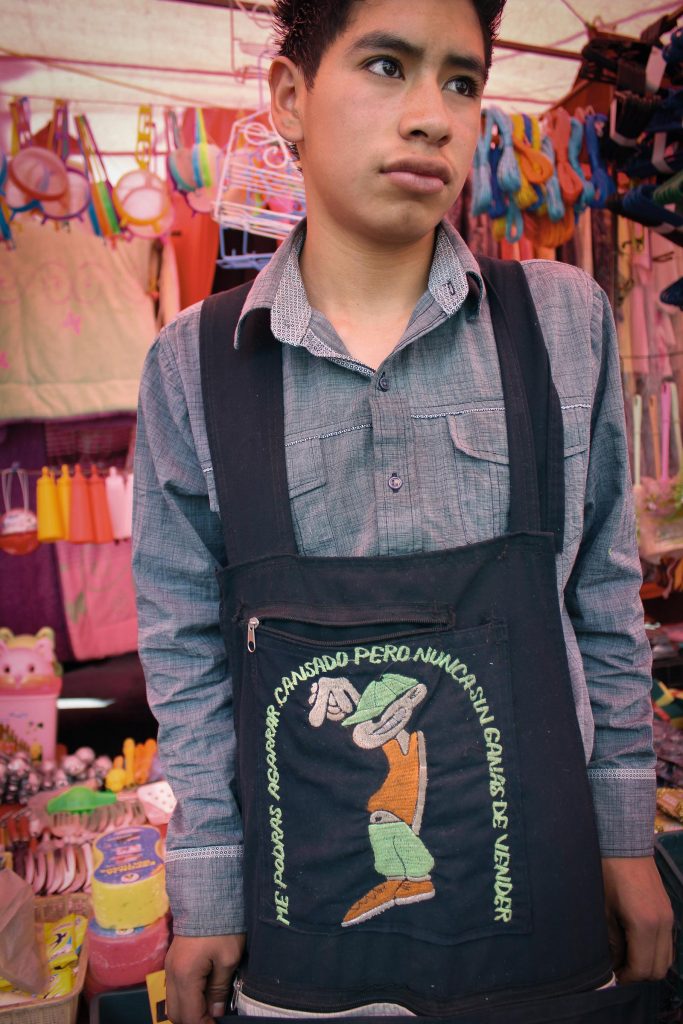

Image 32
Improvisation
CDMX, 2012.
At the end of the day, diableros, fleteros and vendors meet again to exchange notes and anecdotes of the day while the leaders see to it that no one is left behind and that the garbage is collected. Leaving the street dirty would mean one more complaint to the detriment of the Ruta 8 installation. Sometimes this task can last until ten o'clock at night, as the garbage collectors are often late. In some neighborhoods, Ruta 8, through quotas, hires private garbage collection services because, according to the tianguistas, the public service often does not show up.




